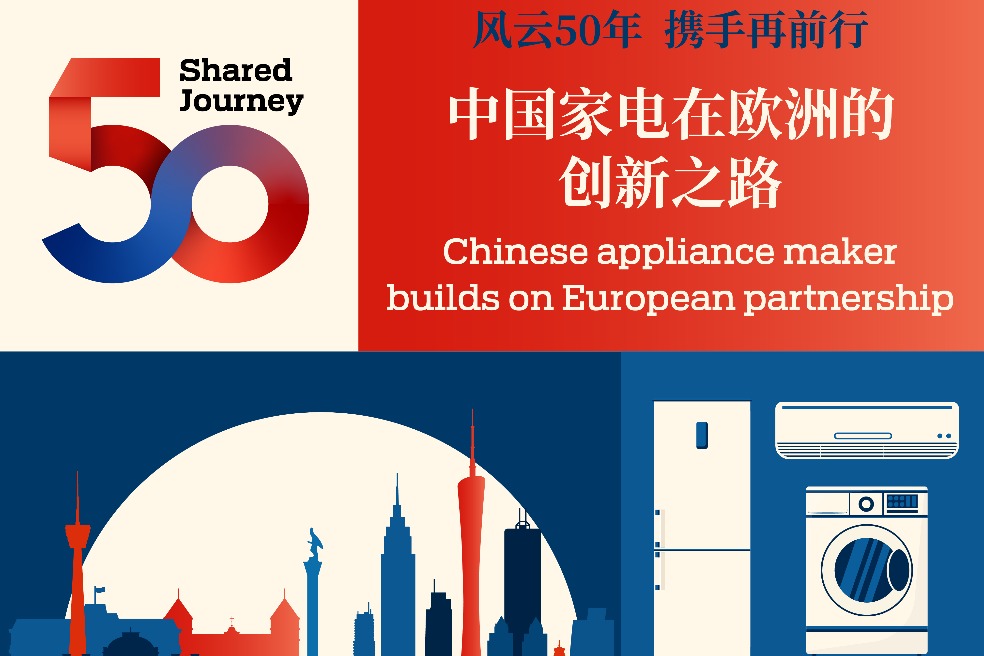Exoskeleton tech sheds light on future delivery

Couriers are often viewed as today's "unsung heroes" as they supply people with their daily needs amid the COVID-19 pandemic. One deliveryman in Shanghai actually resembles a modern hero. Think Sam Bridges in computer game Death Stranding.
In the game developed by Kojima Productions, Bridges must help reconnect the world by delivering important cargo across a ravaged wasteland.
Wearing a robot exoskeleton like Bridges, the worker for food delivery service Eleme appeared on a Shanghai street on April 20. He carried three take-out boxes on his back. The hashtag "robot exoskeleton for food delivery" was viewed more than 20 million times on Sina Weibo by Thursday.
It comes as no surprise then that a pilot program is underway, involving robot developer ULS Robotics and Eleme to explore the potential of exoskeleton suits in the delivery sector.
"The device can help a deliveryman easily carry items weighing 50 kilograms. It will be especially helpful when couriers deliver to communities without elevators and areas with a ban on electric bikes," says Zhang Hua, chief marketing officer of ULS Robotics, a Shanghai company established in 2018.
Eleme responded in its Sina Weibo account on April 21, "We are still exploring the future." The company thanked ULS Robotics for its tech support.
According to ULS Robotics, the device in testing is an intelligent HEMS-GS lower extremity exoskeleton robot, purely driven by electricity.
The robot can operate for five hours at a stretch and can be applied in various sectors such as manufacturing, construction, logistics, pension assistance, military and other fields.
"The robot can also be used in military rescue, supply and logistics," Xu Zhenhua, founder and chief executive officer of the ULS Robotics, says.
Although exoskeletons have been used in a wide variety of medical and industrial settings and the market is expected to grow dramatically in the coming years, most people think it is a concept for the future, Zhang says.
First being used in the medical rehabilitation and military sectors, exoskeletons have been adopted by various sectors.
"We have already cooperated with several companies covering fields such as auto manufacturing, home appliances, logistics and airports," Zhang says.
In September, the company's MAPS-Y upper extremity exoskeleton robot underwent tests at Beijing Daxing International Airport.
In November, ULS Robotics delivered its first exoskeleton to the SAIC-GM Jinqiao Cadillac plant.
Referred to as industrial exoskeletons, these robots can help effectively reduce the strain on workers' bodies in labor-intensive auto assembly plants.
"In everyday life, the potential of exoskeletons could be wide, like what we have explored in the delivery field," Zhang says.
In March 2019, the Tokyo Organizing Committee of the Olympic and Paralympic Games announced that backpack-like powered exoskeleton robots developed by Panasonic will be used in the backstage areas of venues and airports to assist workers in unloading and transporting heavy objects, including food, equipment and luggage.
Other companies producing exoskeleton products include Beijing soft exoskeleton system developer C-Exoskeleton, Shanghai rehabilitation robot maker Fourier Intelligence, Hangzhou RoboCT Technology in Zhejiang province and Shenzhen Milebot Robotics Technology Co in Guangdong province.
With the great potential in logistics sector, retail company Sunning unveiled a self-developed exoskeleton last year to help its warehouse workers.
In 2018, e-commerce giant JD applied exoskeleton robots developed by C-Exoskeleton.
In early April, the National Medical Products Administration granted approval to RoboCT's UGO210 lower extremity exoskeleton walking rehabilitator as companion diagnostics products, according to industry analysis website 36Kr.
Besides these scenarios, Zhang says exoskeletons may one day become a part of your life, like smartphones.
"It can help people climb mountains, assist the elderly in everyday tasks and even help in workouts," he says.
At the Consumer Electronics Show 2020 in January in Las Vegas, South Korea's tech giant Samsung unveiled Gait Enhancing and Motivation outfit that pairs with augmented reality glasses. It gives users workout instructions.
China's exoskeleton market is in early phase with its scale increasing from 6.2 million yuan ($877,000) in 2017 to nearly 45 million yuan the following year, according to Beijing market consultancy Intelligence Research Group.
Amid the country's waning demographic dividend and rising aging population, industry experts estimate that the exoskeleton market size has high growth potential, which has caught investors' attention.
In February last year, ULS Robotics gained millions of yuan in the angel investment led by Future Capital, with K2 Angel Partners as the follower.

Today's Top News
- Disrupting market under fabricated veneer of 'national security' hurts US' own interest: China Daily editorial
- Yasukuni visit would add insult to injury: China Daily editorial
- Judicial reform critical for modernizing governance
- Effective use of investment emphasized
- China's shuttle diplomacy strives to reach ceasefire
- Nanjing Museum's handling of donated art, relics being probed






























